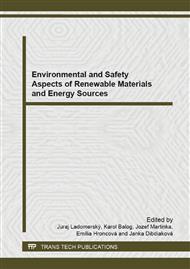[1]
BRADÁČOVÁ, I., 2007: Buildings in terms of fire safety. 1. Edit. Brno: ERA group, 2007. 156 p. ISBN 978-80-7366-090-1.
Google Scholar
[2]
GALLA, Š. – IVANOVIČOVÁ, M., 2013: Assessment of fire risk of selected agglomerated wooden materials. In: Research Journal of Recent Sciences, 2013, Vol. 2 (7), pp.43-47. ISSN 2277-2502.
Google Scholar
[3]
HAGEN, M. – HEREID, J. – DELICHATSIOS, M.A. – ZHANG, J. – BAKIRTZIS, D., 2009: Flammability assessment of fire-retarded Nordic Spruce wood using thermogravimetric analyses and cone calorimetry. In: Fire Safety Journal. ISSN 0379-7112, 2009, vol. 44, no. 8, pp.1053-1066.
DOI: 10.1016/j.firesaf.2009.07.004
Google Scholar
[4]
KAČÍKOVÁ, D. – NETOPILOVÁ, M. – OSVALD, A., 2006: Wood and its thermal degradation. SPBI Edition SPEKTRUM 45. Association of Fire and Safety Engineering, Ostrava, 2006. 79 s. ISBN 80-86634-78-7.
Google Scholar
[5]
MAKOVICKÁ, L. – GAŠPERCOVÁ. S., 2010: The most widely used methods for increasing the fire resistance of timber structures. In Delta : Scientific-professional journal of the Department of Fire Protection, Technical University in Zvolen. ISSN 1337-0863, 2010, Vol. 4, Nb. 8, pp.11-15.
Google Scholar
[6]
MARTINKA, J. – HRONCOVÁ, E. – CHREBET, T. – BALOG, K., 2014: The influence of spruce wood heat treatment on its thermal stability and burning process, in: European Journal of Wood and Wood Products (2014).
DOI: 10.1007/s00107-014-0805-9
Google Scholar
[7]
MARTINKA, J., CHREBET, T., BALOG, K.: An assessment of petrol fire risk by oxygen consumption calorimetry. In: Journal of Thermal Analzsis and Calorimetry. (2014), In print.
DOI: 10.1007/s10973-014-3686-6
Google Scholar
[8]
MÜLLEROVÁ, J., 2013: Fire safety properties of heat treated wood. In: Research journal of recent sciences. 2013, Vol. 2, no. 12 (2013), pp.80-82. ISSN 2277-2502.
Google Scholar
[9]
MÜLLEROVÁ, J., HLOCH, S., VALICEK, J.: Reducing Emissions from the Incineration of Biomass in the Boiler. In: Chemical Letters. 2010, Vol. 104, Issue 9 (2010), s. 876-879. ISSN 1213-7103.
Google Scholar
[10]
OSVALD, A. a kol., 2009: Evaluation of materials and structures for fire protection needs. Technical University in Zvolen, Zvolen, 2009. 355 p. ISBN 978-80-228-2039-4.
Google Scholar
[11]
OSVALD, A., 2013: Residential wooden buildings, part III. - Wood protection. In: Spravodajca, Nb. 1/2013, Vol. XLIV., pp.22-25. ISSN 1335-9975.
Google Scholar
[12]
REINPRECHT, L., 2008: Protection of wood and composites. Technical University in Zvolen, Zvolen, 2008. 453 p. ISBN 80-228-0690-0.
Google Scholar
[13]
WALD, F. et al ., 2005. Calculation of fire resistance of building structures. ČVUT, Praha, 2005. 336 p. ISBN 80-01-03157-8.
Google Scholar
[14]
Act no. 50/1976 Coll. on Spatial Planning and Construction (Building Act), as amended.
Google Scholar
[15]
Act no. 90/1998 Coll. on construction products, as amended.
Google Scholar
[16]
Regulation no. 305/2011 laying down harmonized conditions for the launching of construction products on the market.
Google Scholar
[17]
STN EN ISO 11925-2: 2010: Ignitability of products subjected to direct impingement of flame - Part 2: Single-flame source test.
DOI: 10.3403/02510382u
Google Scholar
[18]
STN EN 13501-1 + A1: 2010: Fire classification of construction products and building elements. Part 1: Classification using data from reaction to fire tests.
DOI: 10.3403/30348263
Google Scholar


